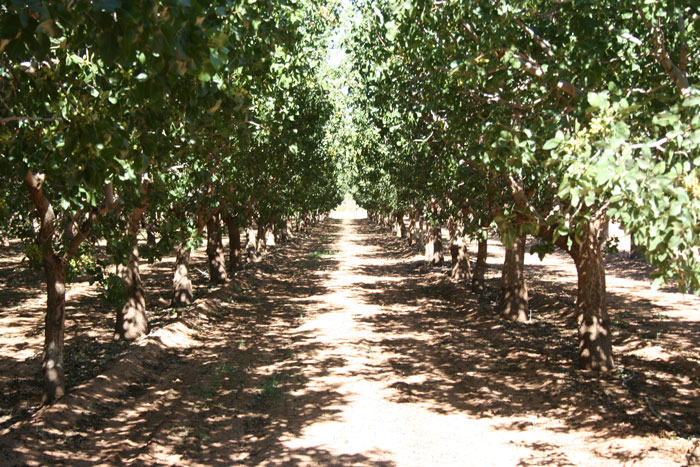
Alternaria late blight may not be the most costly disease threat to California pistachio growers, but it’s probably the most difficult to manage. That reflects its ability to stand up to some types of chemicals used to control other fungal diseases, says Themis Michailides, University of California plant pathologist at the Kearney Agricultural Research and Extension Center, Parlier, Calif.
Scientists have been studying the disease in California for the past three decades. “The pathogen has been able to develop resistance to various fungicides fairly quickly,” Michailides says. “Over the years we’ve found high levels of resistance to FRAC Group 7 (boscalid, carboxin and flutolanil) and FRAC Group 11 (strobilurin) products.
Alternaria can lower quality and production of a pistachio crop significantly by causing nut staining, early defoliation and, in some cases, moldy nuts.
High temperatures combined with high humidity, including dew formation, favor growth of the disease pathogens. However, despite the dry weather last year, some areas with a history of alternaria suffered severe outbreaks of the disease, Michailides reports.
“That’s not surprising, since the microclimate in an irrigated orchard can become quite humid, particularly if there’s little air movement,” he says.
Michailides contrasts that to such areas as the West Side. There, even though growers may use the same cultural practices as those in areas prone to the disease, Alternaria is seldom a concern due to the windier conditions that help minimize humidity levels and keep the disease at bay.
However, with California’s increasing acreage of irrigated pistachio and almonds (which are also susceptible to Alternaria) Michailides expects the disease to become more widespread in the future.
Sometimes growers can confuse symptoms of Alternaria with several other diseases, Michailides notes.
Alternaria is characterized by dark brown spots or lesions on leaves with blackened centers, which contain the disease-causing spores. Rubbing these lesions leaves a black color on the finger.
Botryosphaeria dothidea causes leaf lesions, too. But, rubbing them doesn’t blacken fingers.
However, both fungi can be present in the same lesion late in the season. The only way to distinguish the two is with microscopic analysis, Michailides notes,
Peters Scorch, a noninfectious disorder usually found only in male pistachio trees and mostly Peters, also produces leaf lesions. They first appear in late June and during July as black angular lesions with exuded black gum in the center before becoming light green and then brown and necrotic. Trees with Peters scorch defoliate earlier than non-scorched trees, Michailides adds
One key to distinguishing these diseases is timing of formation of the lesions. “Infection with Alternaria occurs early in the season, but remains dormant until the fungi begin producing the first lesions later in the season, usually around the start of August,” Michailides says. “That’s why it’s called Alternaria late blight. If you see lesions on the foliage in May or June, most likely they’re caused by Botryosphaeria. The lesions associated with Peters scorch usually start appearing in June.”
However, waiting to begin fungicide applications until Alternaria lesions appear is too late for effective control, Michailides says.
He advises making as many as three or four fungicide applications, if necessary, to control Alternaria, beginning in early June and finishing by the end of July. If you’re making just one application, the best time to spray is between the end of June and no later than July 4.
Done properly, treatment using products to which Alternaria has not developed resistant can be very effective in fighting the disease.
“Take steps to avoid development of fungicide resistance,” Michailides says. “Rotate among the fungicide classes and avoid repeated use of one class of fungicides. Use full rates and good spray coverage to help reduce buildup of resistance by the pathogen,”
Even then, though, controlling Alternaria calls for a combination of management approaches.
“If you’re orchard is in an area conducive to Alternaria, managing the disease requires an aggressive control program, featuring both fungicide treatment and cultural practices, year-in and year-out,” he says. “Once the Alternaria fungi get into a field the disease will show up almost every year.”
The cultural practices are aimed at reducing humidity levels in the orchard. They include:
Planting orchards in north-south rows to improve air circulation;
Hedge pruning in winter to open up tree canopies;
Controlling growth of tall, dense weeds on the orchard floor;
If the disease is serious, adjust the irrigation schedule and add calcium-based soil amendments, such as gypsum, to minimize standing water from August to harvest;
When using water management techniques, Michailides recommends weighing damage from the disease against the impact of deficit irrigation on shell splitting.
More information about Alternaria and control recommendations is available at www.ipm.ucdavis.edu
About the Author(s)
You May Also Like




